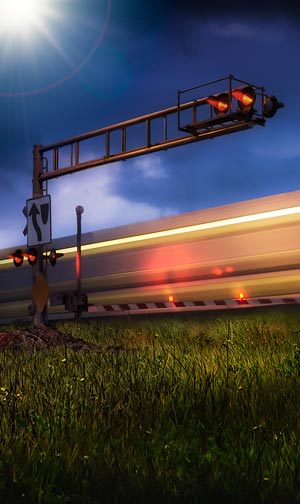Five Tree Trimming Workers Injured by Amtrak Train at Dangerous, Unguarded Crossing
(Berlin, Connecticut – June 23, 2014)
Five employees of a Houston, TX-headquartered tree trimming contractor were hospitalized Monday morning after their truck became stuck on a locked gate just across the Norton Lane grade crossing of Amtrak-owned railroad tracks through the community of Berlin, CT at about 9:45 A.M., EDT, and was hit by a Springfield, MA-bound Amtrak train carrying 45 passengers.
The driver of the truck was still in the vehicle attempting to dislodge it as the train struck them at an estimated 70 mph. The other four injured workers, who had vacated the area of the truck, were struck by flying debris as the truck, which was hauling a wood chipper on a trailer, was flipped by the train and the trailer and its load carried some distance beyond the impact site, where both the wreckage and the train locomotive caught fire. The truck, chipper and trailer were owned by and the injured workers employed by Trees, Inc., and were performing work for the Northeast Utilities electrical power company. No word on the extent of their injuries was available.
The crossing of Amtrak rails and Norton Lane, which is listed as private and therefore exempt from requiring locomotive engineers to sound train horns as they approach. It is also unguarded by any active protective devices, such as flashing lights, bells and crossing gates. According to Federal Railroad Administration reports, Monday’s multiple-injury accident was the fourth train/motor vehicle encounter to occur at the crossing. Also, a daily average of 17 trains, most of them Amtrak, cross there at a maximum authorized speed of 80 mph with no advance warning to vehicles such as the tree trimming truck.
It is virtually certain that lights and gates would have prevented this tragedy. Both Amtrak and Operation Lifesaver know lights and gates are the most effective type of protection at railroad crossings. Studies that have been conducted over fifty years ago confirm that lights and gates offer the ability to drastically reduce the number of vehicle/train accidents by as much as 96%.
The crossing, which is the sole access for the farm home of the Joe Lagosz family, has a horrific history, having been the site of an eight-fatality accident on March 8, 1960 – over a decade prior to the establishment of the Federal Railroad Administration and the launch of its railroad grade crossing inventory and accident recording system in the early 1970’s – when Emily Whitaker, an employee of the Lagosz family who lived on the farm site, was crossing there as she hauled her seven foster children to school in her station wagon that fateful morning. All eight died when a train struck the vehicle, scattering auto parts and victims across the frozen landscape.
Joe Lagosz was 12 years old at the time he overheard his father describing the carnage, and he never forgot it. Now, following the most recent accident which injured five members of a tree trimming crew Monday morning, Lagosz is continuing to pursue his battle to have the crossing’s safety factors improved. “I have been harping on the town and the state to do something. It’s a dangerous crossing.”
If an octuple fatality was not enough to get action, Monday’s quintuple injury accident will undoubtedly suffer the same degree of attention.
Lagosz said he had told Connecticut Light & Power, a subsidiary of Northeast Utilities, which had contracted the operation from Trees, Inc., his cell phone number so that he could be called by the crew to unlock and open the gate. He says he never received a call from anyone.
His fear of the crossing continues today, as Meriden Record-Journal Staff Writer Jesse Buchanan noted in her Wednesday follow-up article/interview in regard to Monday’s accident. “Curves in the track and embankments reduce visibility,” Buchanan quoted Lagosz. He warns others about the crossing, and when he or family or friends cross it, he tries to be present. And when he crosses it himself? “You cannot hesitate. You put your foot on the gas and you go,” he described.
Talking to news media, among them reporters from The Berlin Citizen, Berlin Fire Chief James Simon mused “You want to know what the truck looks like? It looks like it was hit by a train going 70 miles per hour!”
The Berlin Amtrak crash came on the heels of a Sunday night tragedy on Amtrak rails in the Boston area community of Mansfield, MA where a vehicle with three occupants inside and somehow traveling on railroad right-of-way, collided with another Amtrak train, resulting in fatal injuries to all three individuals as well as derailing part of the train.
“This is a tough day for Amtrak,” remarked Connecticut Governor Dannel Malloy at a Monday afternoon news conference. The Governor was on his way to a hurricane emergency drill in Milford, CT, but stopped in Berlin for an update on the accident as well as to survey the damage it caused.


